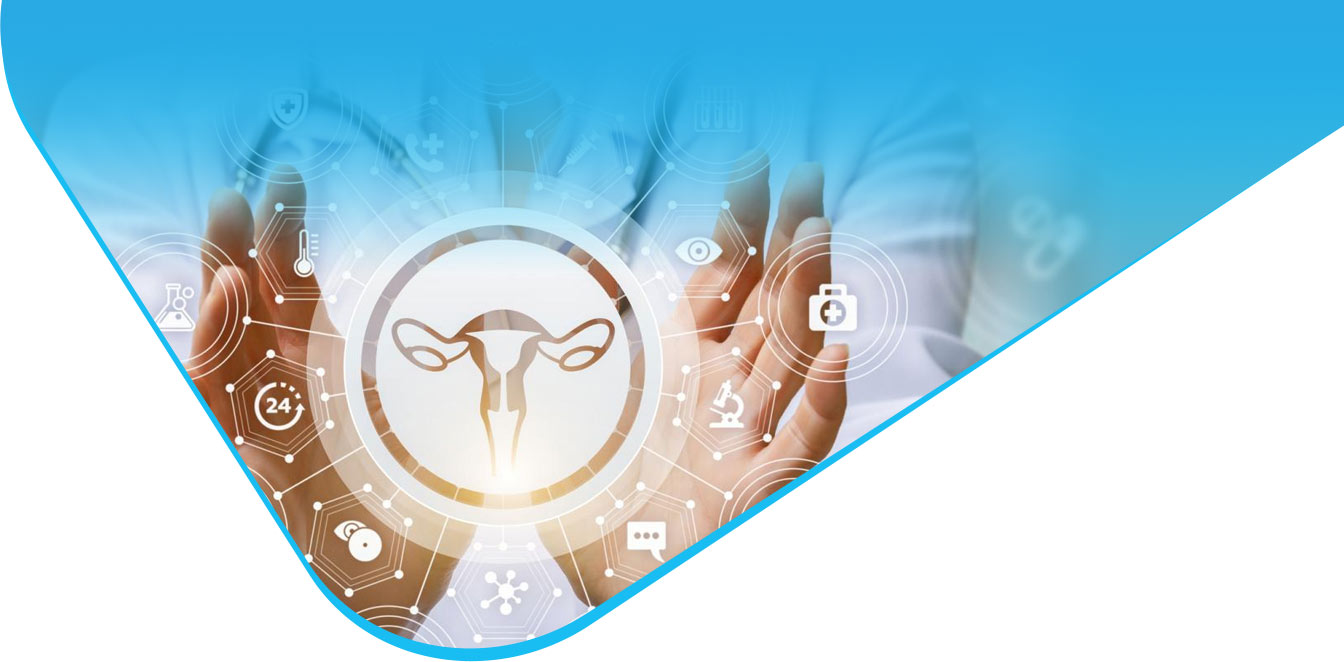Endometriosis Treatment Center
We specialize in the surgical treatment of endometriosis which are performed laparoscopically or with the use of a robot
At the Endometriosis Treatment Center at the Kliny Hospital we specialize in the surgical treatment of endometriosis with a team comprising a gynecologist, urologist and surgeon. Due to the complexity and high precision required for surgical treatment of endometriosis these procedures are performed laparoscopically or with the use of a robot in our hospital.
Surgeries supported by the robotic system provide surgeons with the capability to operate in hard-to-reach areas, ensuring precision during the procedure. The tenfold magnification of the surgical field allows the surgeon to remove all tissues affected by endometriosis while preserving and sparing nerves such as those supplying the bladder.
What is endometriosis?
According to estimates one in ten Polish women may suffer from endometriosis which means that as many as 2 million women in our country could be affected by this condition. Endometriosis is the second most common disease among young women also known as adenomyosis or wandering uterine lining. This condition is characterized by the abnormal growth of the endometrium (the lining of the uterus) which occurs outside the uterine cavity. Endometriosis lesions most commonly locate in the ovaries, fallopian tubes, intestines, ureters, and bladder.
Currently, there are three types of endometriosis:
- Peritoneal endometriosis, where lesions of varying sizes occur depending on the stage of the disease.
- Ovarian endometriosis, where the typical symptom is the formation of endometrial cysts on the ovaries.
- Deeply infiltrating endometriosis, which involves all changes below 5 mm from the peritoneal surface (primarily located in the rectum, bladder, or rectovaginal space).
Endometriosis is mainly diagnosed in young women between the ages of 20 and 40. However, in recent years, more cases are being diagnosed during puberty, and it can also occur after menopause.
Robotic-Assisted Surgery for endometriosis treatment
At the Endometriosis Treatment Center in Szpital na Klinach we offer advanced surgical options for the treatment of endometriosis using both laparoscopic and robotic-assisted techniques. Due to the ergonomic and technical limitations of traditional laparoscopy, robotic-assisted surgery is increasingly utilized in such procedures, greatly facilitating the precise execution of complex operations. The robot, equipped with miniaturized instruments, high-resolution 3D visualization and systems that eliminate the natural hand tremors of the surgeon is particularly beneficial for performing surgeries on deep infiltrating endometriosis (DIE). The use of the robot significantly enhances the effectiveness of removing endometriosis-affected tissues while allowing for the precise preservation of critical nerve structures, such as those supplying the bladder. This ensures that the surgeries are not only more efficient but also better at maintaining nerve functions which directly improves the quality of life for patients post-operation.
Currently, there are three types of endometriosis:
- Peritoneal endometriosis, where lesions of varying sizes occur depending on the stage of the disease.
- Ovarian endometriosis, where the typical symptom is the formation of endometrial cysts on the ovaries.
- Deeply infiltrating endometriosis, which involves all changes below 5 mm from the peritoneal surface (primarily located in the rectum, bladder, or rectovaginal space).
Endometriosis is mainly diagnosed in young women between the ages of 20 and 40. However, in recent years, more cases are being diagnosed during puberty, and it can also occur after menopause.
Endometriosis – Symptoms
Endometriosis is a disease with various manifestations and can cause a wide range of symptoms, making early diagnosis challenging. Typical symptoms of endometriosis include pain of varying location and intensity, occurring mainly before or during menstruation. Women with endometriosis often experience painful, prolonged, and heavy menstrual periods. Other symptoms of this disease include pain during bowel movements or after defecation, pain during intercourse, and symptoms resembling bladder inflammation.
The pain associated with endometriosis is primarily due to the formation of adhesions resulting from the inflammation caused by the disease, as well as the infiltration of nerve fibers and the accumulation of blood components in the endometriotic lesions.
Women of reproductive age suffering from endometriosis often face difficulties in conceiving. It is estimated that half of the women undergoing infertility treatment are affected by endometriosis.
Endometriosis – Diagnosis
Despite the prevalence of this disease, the average waiting time for a diagnosis in Poland is about 10 years from the first symptoms. This delay occurs because there is a common belief in society that menstruation must be accompanied by pain, which is often ignored by patients, leading them not to report these symptoms to their doctors. Diagnostic delays not only result in years of pain but also often cause the loss of opportunities for motherhood and a normal life.
However, diagnosing endometriosis is not overly complicated in most cases, as the disease can often be detected through a simple ultrasound examination (performed transvaginally or rectally in the case of intestinal symptoms). This imaging allows for the visualization of endometrial lesions. Additional diagnostic tools include CT colonography and magnetic resonance imaging (MRI).
Endometriosis – Treatment
For this condition, treatment typically involves either pharmacological therapy or surgical intervention. Pharmacological treatment includes the use of contraceptives, progestogens, and medications that reduce the secretion of gonadotropins and estrogens. The goal of pharmacotherapy is to inhibit the growth of the uterine lining and endometriotic lesions. If conservative treatment does not lead to improvement and the patient continues to experience symptoms, surgical intervention is recommended. The surgical procedure aims to remove adhesions that cause pain, eliminate endometriotic lesions, and restore the normal functioning of pelvic organs.
Endometriosis – Surgical Treatment – for whom?
The Polish Gynecological Society recommends surgical treatment for endometriosis in patients who experience the following conditions during the course of the disease:
- Chronic pain, dyspareunia, and painful menstruation
- Deterioration in quality of life
- Pharmacological treatment does not yield the desired effects or cannot be applied
- Diagnosed painful nodules in the sacro-uterine ligaments or nodular changes
Infertility (when tests do not confirm any other pathologies)
Endometriosis – Surgical Treatment
The standard in surgical treatment for endometriosis is the minimally invasive approach using laparoscopy. Laparoscopic surgery has many advantages over the open (traditional) technique, including shorter hospitalization, reduced pain, lower risk of postoperative complications, and better cosmetic results. However, laparoscopic surgery has some inherent technical limitations, such as a two-dimensional view, limited range of motion, a narrow operative field, and the absence of anatomical landmarks. Therefore, the surgeon’s experience is crucial to perform optimal surgery with proper and complete excision of endometriosis.
Due to the technical and ergonomic limitations of laparoscopic surgery, robotic surgery is increasingly being used in the surgical treatment of endometriosis. The robotic system is particularly helpful for safely performing radical surgery for deeply infiltrating endometriosis (DIE). The use of a robot allows the surgeon to overcome the limitations of conventional laparos
Due to the technical and ergonomic limitations of laparoscopic surgery, robotic surgery is increasingly being used in the surgical treatment of endometriosis. The robotic system is particularly helpful for safely performing radical surgery for deeply infiltrating endometriosis (DIE). The use of a robot allows the surgeon to overcome the limitations of conventional laparoscopy with miniaturized instruments, tenfold magnification of the image in full HD 3D quality, and flexible movements of the robot arms, which eliminate the natural hand tremors of the operator.
At the Endometriosis Treatment Center at Kliny Hospital, we offer patients the option of surgical treatment for endometriosis using both laparoscopic techniques and robotic assistance. The diagnosis and treatment of endometriosis patients are managed by an interdisciplinary team comprising specialists in gynecology, diagnostic imaging, urology, surgery, psychological support, and rehabilitation. The goal of the treatment process at the Endometriosis Treatment Center is not only the physical recovery of the patient but also the achievement of a full quality of life after the procedure. We also ensure post-operative comfort by providing psychological and rehabilitative care for our patients.
Physiotherapy in Endometriosis
Different locations and structures of endometriosis lesions can limit the function and mobility of the intestines, ovaries, fallopian tubes, and uterus, as well as impair the function of the digestive system and kidneys. For this reason, physiotherapy is an integral part of endometriosis treatment, tailored individually to the needs of each patient. The use of physiotherapy in the treatment of endometriosis primarily focuses on normalizing tension in the pelvis, abdominal organs, relaxing pelvic floor muscles, and alleviating pain responsible for constant muscle tone elevation.
For patients with endometriosis our Hospital has developed a unique physiotherapy program aimed at improving functional status and reducing pain by combining the efforts of a physiotherapist and a dietitian. Pain management therapy for endometriosis includes a series of consultations, including one dietary consultation and five physiotherapy sessions, along with an individually tailored therapy plan. To maintain the benefits of therapy, it is recommended to incorporate targeted pain management therapies during the premenstrual period and to complete the full cycle of physiotherapy.
Our specialists
The Endometriosis Treatment Center at Kliny Hospital is composed of an interdisciplinary team of specialists including gynecologists, a urologist, a general surgeon and a rehabilitation therapist.












